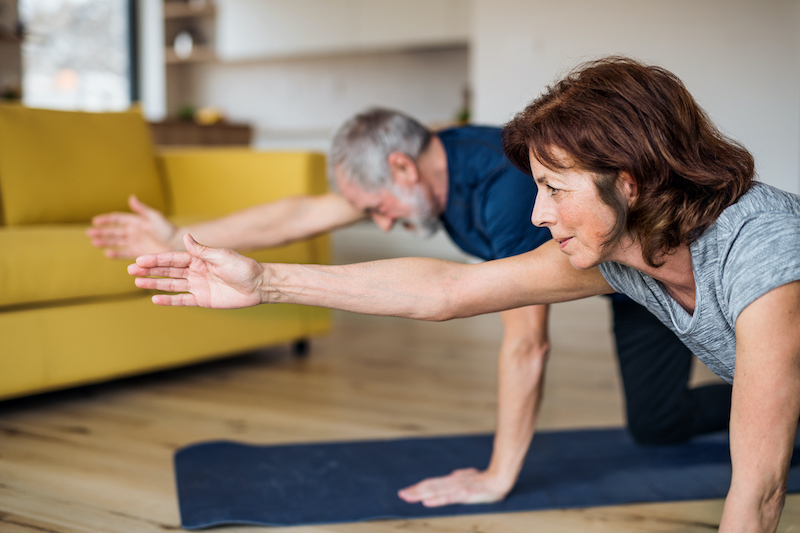The body – at any age – was designed to move in order to maintain itself, so exercise is vital to physical and mental health. Finding opportunities for exercise, or even simple movement, can be challenging, as some older adults may have limited mobility or access to participate in exercise classes or go to gyms. Some may have decreased motivation to stay active at all.
In-home cardio and weight exercises for seniors can help with lack of motivation and get older adults moving from the comfort of their home.
What can and should a senior do in an in-home exercise program?
First, a physician should always be consulted before beginning an exercise program. One size does not fit all. For example, seniors with chronic health conditions will require a program that fits with their personal health challenges.
Keys to Effective Exercise
An exercise program should improve or maintain a person’s fitness level without causing injury or too much fatigue. Therefore, the program should be one the senior can follow consistently and without too many challenging aspects to it.
Also, the senior must learn what exercises are beyond his or her capacity. Some temporary soreness when first starting an exercise regimen is normal; persistent pain is not.
Finding a variety of cardio and weight exercises for seniors is important to make the activity more fun and the senior less susceptible to burn out. Workouts for seniors do not always have to include barbells or treadmills. Gardening, walking, and performing household chores can also count as effective activities.
Exercise routines can also be broken up into segments—a few minutes a day of different exercises or activities can help create a regimen that hopefully can be adhered to more easily.
Aside from strength and cardiovascular health, seniors should also concentrate on areas like balance and flexibility. Let’s explore the benefits and exercises specific to each of these areas:
Cardiovascular Exercise
What defines cardiovascular exercise and how much does a senior adult need?
The American Heart Association defines it as exercise of moderate to vigorous intensity.
However, age is an important factor in determining the recommended heart rate for cardiovascular exercise. As you age, the average beats per minute of your heart rate while you are exercising decreases.
Therefore, many seniors may opt for low-impact exercises like brisk walking or riding a stationary bike. Activities like gardening and performing household chores that require an increased level of physical exertion can also count as cardiovascular activities.
The American Heart Association also provides information about how to determine the heart rate zones for each of these levels of activity.
Remember, optimal exercise intensity and duration will vary from person to person. All seniors may not be able to sustain the recommended levels of activity and several types of medications can lower your heart rate below your target zone. Be sure to consult with a physician about your exercise options.
Strength Training
Strength training is recommended at least twice a week for senior adults. Resistance can be provided by weights, elastic bands, or a person’s body weight. It has been shown to help with fall prevention, muscle mass retention, improved posture and increased bone density.
Some equipment-free, at-home weight exercises for seniors include:
Squats using a chair. Stand with feet shoulder-width apart directly in front of a chair. Push your hips back and bend your knees to lower your body to the chair. Then, keeping your back straight, use your legs to push yourself up to a standing position and repeat.
Wall pushups. Stand about two feet from a wall, while facing it. Put your palms against the wall at about shoulder height. Then push yourself away to an upright position. Bend your elbows and lower yourself to the wall for the next repetition.
Calf raises. Stand behind or beside a chair or counter and place your hands on it for support. Raise yourself up on your tiptoes and then lower yourself back to the flat-footed position.
Single foot stand. Stand behind a steady, immovable chair and hold onto the back. Pick up one foot and balance as long as it is comfortable. Switch legs and repeat.
Flexibility and Balance Training
The SilverSneakers senior exercise program lists 7 stretching exercises for adults with videos on how to perform each stretch.
Flexibility is important for seniors because they are more susceptible to stiff joints and tight muscles. The site demonstrates side, shoulder, triceps, hamstring, calf, knee and chest stretches.
Balance training for fall prevention is vital for seniors as well. SilverSneakers provides six demonstration videos on balance exercises to promote stability.
Exercise Summary
Mix and match exercises to find out what works best for you.
You can combine strength and cardiovascular training on the same day, although it is recommended you do the strength portion of the workout first, because a cardio workout can lessen your ability to strength train. Try alternating strength and cardio on opposite days, and perform balance and flexibility workouts for a warmup.
Apart from improving overall health, a main focus of regular exercise for seniors is to maintain their physical ability to successfully perform daily tasks — carrying a bag of groceries, climbing stairs, reaching up for an item on a shelf or taking a walk with a grandchild.
Exercise benefits for senior adults include:
- Fall prevention
- Decrease in pain and depression
- Increased endurance
- Better control of chronic diseases
- Increased bone density
- Maintained muscle mass
- Better balance and flexibility
A lack of movement feeds upon itself. The less you move the harder it will be to perform daily tasks, and in the end discourage you from breaking the cycle of inactivity. Try to be active each day, even if it’s a small amount of time. In the end, your body and mind will thank you.
To learn more about maintaining an active and healthy lifestyle, check out the Health & Wellness section of our blog.
Want to find out more?
If you’d like to stay up to date with Bethesda Health Group, sign up here to receive our blog and newsletters!
"*" indicates required fields
Related Articles
Want to find out more?
If you’d like to stay up to date with Bethesda Health Group, sign up here to receive our blog and newsletters!
"*" indicates required fields



